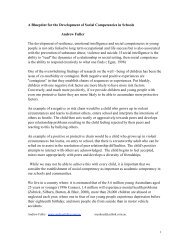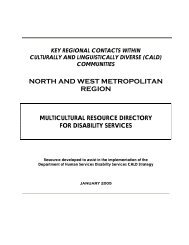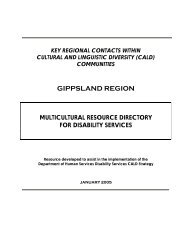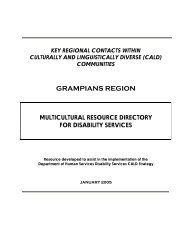Positive Behaviour Support - Department of Human Services - Vic ...
Positive Behaviour Support - Department of Human Services - Vic ...
Positive Behaviour Support - Department of Human Services - Vic ...
Create successful ePaper yourself
Turn your PDF publications into a flip-book with our unique Google optimized e-Paper software.
46 <strong>Positive</strong> behaviour support: Getting it right from the start - Facilitators reference manual<br />
PowerPoint 66*<br />
• The ability to imitate<br />
Imitation is a skill that we develop very early. During our communication development we are<br />
imitating the actions, sounds and eventually words <strong>of</strong> the people around us.<br />
Does the person you support have intentional communication skills?<br />
Give examples that support your view.<br />
The Communication continuum<br />
In order to identify a person’s communicative abilities we need to think <strong>of</strong> the development<br />
<strong>of</strong> communication as occurring on a continuum: from an unintentional stage through to an<br />
intentional symbolic stage. As we are all developing and learning to communicate we progress<br />
through this continuum.<br />
We learn that by communicating we can have an effect on the people in our environment, and<br />
can use them to obtain what we want and need (cause and affect).<br />
For example: Sally does not use speech to communicate and she is in a wheel chair. Sally wants<br />
her favourite song turned up louder, but she can't reach, so she claps to gain the attention <strong>of</strong> Fred<br />
and points at the stereo. Fred asks Sally what she wants and she again gestures by pointing in the<br />
direction <strong>of</strong> the stereo. Fred turns up the music. Sally has learnt the link between communication and<br />
manipulating her environment.<br />
Some people with a disability have not yet developed all <strong>of</strong> the prerequisite skills needed to be<br />
an intentional communicator. Others have, but are not yet using symbols to communicate. In<br />
order to support the communicative needs <strong>of</strong> people and develop effective support plans we<br />
must have an understanding <strong>of</strong> where the person’s communication skills are on the continuum.<br />
A tool such as the ‘Checklist <strong>of</strong> communication competencies’ 10 can be used to help you<br />
determine this and best plan for the support required.<br />
10. Bloomberg K, & West, D (1999), The Triple C : Checklist <strong>of</strong> Communication Competencies.<br />
Triple C Copyright <strong>of</strong> SCIOP












